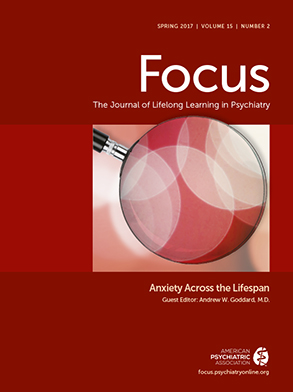Clinical Vignette
Ms. Sanders was a 26-year-old married woman with a one-year-old child, Bobby. Ms. Sanders was contemplating returning to work as a bank teller and having Bobby attend day care. However, her chronically high level of anxiety had increased to a disabling level over the past several months. She was unable to sleep, getting up multiple times a night to ensure that Bobby was all right. She worried about all of the “horrible things” that could possibly happen to him in day care. She did not want to take little Bobby out of the house because she was afraid that he might be abducted or get hurt. She hesitated to give him solid foods, for fear that he could choke. She experienced a surge of terror if he sneezed or coughed, immediately calling the pediatrician for an appointment.
Bobby’s pediatrician expressed concern about Ms. Sanders’ level of anxiety. “Bobby is perfectly healthy, Ms. Sanders,” he had reassured her. After the second urgent pediatric visit that month for no discernible illness, the pediatrician had told Ms. Sanders that she needed to take care of herself, too. He referred her for a psychiatric evaluation of her anxiety and possible depression.
Ms. Sanders appeared wan, vigilant, and anxious as she entered the psychiatric waiting room. Bobby was held securely in her arms as she struggled to get through the door while pushing an empty stroller. She checked in with the receptionist and then sat in a chair as far from others as she could get, clutching Bobby closely. He squirmed and fussed in an attempt to get down, only to be clutched more tightly.
Dr. Kaplan smiled when she invited Ms. Sanders into her office. Bobby continued to squirm and whimper as Ms. Sanders sat down.
“Who is the cute little guy who came with you?” Dr. Kaplan inquired.
“Oh, I’m sorry. Was I not supposed to bring him?” Ms. Sanders blurted in a worried tone.
“No, no. I’m happy to meet him. What is his name?” Dr. Kaplan inquired.
“Bobby,” Ms. Sanders said dully.
“He’s very cute. How old is he?” Dr. Kaplan continued. They chatted for a while about Bobby, who started crying, frustrated by his confinement in his mother’s clutch. Dr. Kaplan got up and moved some breakable items from the coffee table. “Would you like to put down the blanket and let him move around?” Dr. Kaplan asked as Bobby’s howls became ever louder.
“Are you sure it’s okay?” Ms. Sanders questioned timidly.
“Yes,” replied Dr. Kaplan matter-of-factly.
Bobby crawled around the blanket and played with the toys his mother had provided. She swooped in quickly to retrieve him when he attempted to pull himself up. Dr. Kaplan provided distractions for Bobby to allow his mother to talk.
Finally, Ms. Sanders looked up at Dr. Kaplan with an expression of desperation. “I am worried all of the time, Dr. Kaplan. I can’t sleep. I am not eating very well. I am constantly afraid that something will happen to my precious Bobby. I simply couldn’t stand that. But his pediatrician seems to think that I am going to make Bobby a nervous wreck, as well. What can I do?”
Dr. Kaplan reassured Ms. Sanders that it is normal for new parents to worry about their babies. “But he is a year old now and looking healthy and robust. And see how he shows his toys to you? That suggests that he is well-bonded and secure. What are your thoughts about why you are so anxious about such a healthy, happy little boy?” Dr. Kaplan inquired.
Ms. Sanders stopped and thought for a moment. “I was raised by two very successful alcoholic parents,” Ms. Sanders mused. “I think I felt uncared for, even though I had everything I ever wanted—materially, that is. But not much in the way of attention.”
“Wow,” Dr. Kaplan replied with earnest amazement. “You are an insightful, caring mother. No wonder being there for Bobby is so important to you. How about we prioritize your concerns so that we are sure to deal with what is most important to you first?” Dr. Kaplan suggested.
“My sleep!” Ms. Sanders blurted. “I’m afraid to take even melatonin for fear that I won’t wake up if Bobby needs me.”
“And your partner?” Dr. Kaplan inquired.
“My husband just says to go back to sleep and stop worrying all of the time. I don’t think he understands at all,” Ms. Sanders replied. “Bobby is sleeping in our room—in his crib, of course. But Bob, his father, doesn’t seem to wake up when he cries. It’s all on me,” she confessed, a tear rolling slowly down her cheek before she could swish it away.
“Well,” Dr. Kaplan said empathically, “I understand why you feel so upset. That’s a lot of worry for one person to bear alone.”
They then set about jointly making a plan, first addressing Ms. Sanders’ need for sleep. Ms. Sanders suggested that she could talk to her husband and ask him to skip his usual beer before bedtime so that he would sleep more lightly, and she would request that he tend to Bobby during the first half of the night. She would take second shift. They then discussed a light sleeping aid (Ms. Sanders chose melatonin) and the next steps she should take in dealing with her anxiety.
“I don’t want to just take drugs,” Ms. Sanders said urgently. “I want to try to work out my issues with psychotherapy first.”
“That sounds fine,” Dr. Kaplan agreed. “A cognitive-behavioral approach will probably work very well for you. Do you want to start with that?”
“Yes,” answered Ms. Sanders resolutely—the first time she had sounded sure about anything all session. She even flashed a genuine smile as she buckled Bobby into his stroller and accepted Dr. Kaplan’s assistance with the door as she left the office.

